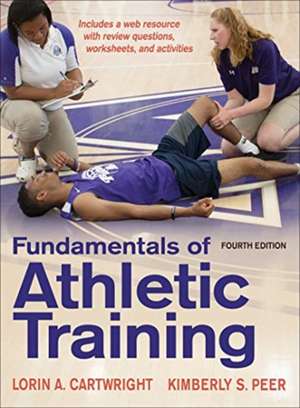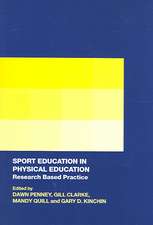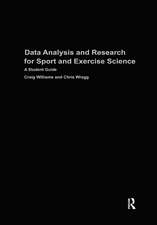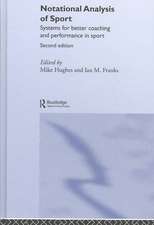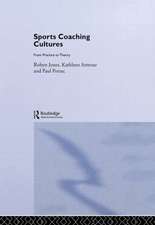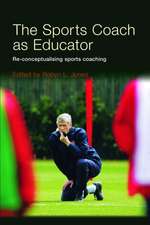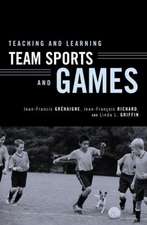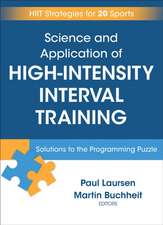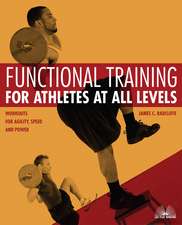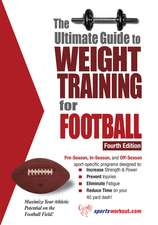Fundamentals of Athletic Training
Autor Lorin A. Cartwright, Kimberly Peeren Limba Engleză Hardback – 18 oct 2018
Preț: 606.52 lei
Preț vechi: 787.69 lei
-23% Nou
Puncte Express: 910
Preț estimativ în valută:
116.08€ • 121.22$ • 96.24£
116.08€ • 121.22$ • 96.24£
Carte disponibilă
Livrare economică 21 ianuarie-04 februarie 25
Preluare comenzi: 021 569.72.76
Specificații
ISBN-13: 9781492561491
ISBN-10: 1492561495
Pagini: 488
Dimensiuni: 287 x 224 x 28 mm
Greutate: 1.54 kg
Ediția:Fourth Edition
Editura: HUMAN KINETICS
ISBN-10: 1492561495
Pagini: 488
Dimensiuni: 287 x 224 x 28 mm
Greutate: 1.54 kg
Ediția:Fourth Edition
Editura: HUMAN KINETICS
Notă biografică
Lorin A. Cartwright, MS, ATC, is a consultant with extensive experience in all aspects of instruction of student athletic trainers. Cartwright earned a bachelor's degree in physical education from Grand Valley State University and a master's degree in education from the University of Michigan. She was the head athletic trainer, assistant principal, and athletic director at Pioneer High School in Ann Arbor, Michigan, where she served for more than 32 years. She was an adjunct professor in athletic training at the University of Michigan for three years. Cartwright also taught at Eastern Michigan University and Concordia University. She currently serves as a private consultant in athletic training and sport management.
Cuprins
List of Anatomical Drawings
Preface
Acknowledgments
Unit I. Professional and Administrative Aspects of Athletic Training
Chapter 1. Athletic Training as a Profession
Roles of the Athletic Trainer
The Sports Medicine Team
Becoming a Certified Athletic Trainer
Athletic Training Careers
National Athletic Trainers' Association
Chapter 2. Administration and Professional Development
Legal Issues
Avoiding Legal Problems
Insurance
Professional Development and Continuing Education
The PREMIER Model
Chapter 3. Design and Development of the Athletic Training Facility
Facility Design and Development
Safety Factors and Planning Issues
Maintenance of Facility and Modalities
Material Safety Data Sheets
Facility Rules
Chapter 4. Documentation and Record Keeping
Medical Terminology Basics
Medical Documentation Notes
Injury Reports and Charts
Patient Confidentiality
Chapter 5. Fiscal Management
Types of Budgets
Designing a Budget
Purchasing
Inventory Management
Chapter 6. The Preparticipation Physical Exam
Preparticipation Format and Parts
Medical Information Forms
Clearance for Participation in Sport
Unit II. Basics of Human Anatomy and Physiology
Chapter 7. Introduction to Anatomy
Anatomical Position
Body Tissues
Classification of Joints
Muscle Movement
Chapter 8. Basics of Tissue Injuries
Soft-Tissue Injuries
Bone Injuries
Unit III. Athletic-Related Injuries to the Head, Spine, and Axial Region
Chapter 9. Head Injuries
Anatomy of the Head
Preventing Head Injuries
Head Injury Mechanisms
Treating Head Injuries
Chapter 10. Facial Injuries
Anatomy of the Facial Region
Preventing Facial Injuries
Treating Eye Injuries and Conditions
Treating Ear Injuries
Treating Nose Injuries
Treating Mouth Injuries
Chapter 11. Throat and Thorax Injuries
Anatomy of the Throat
Anatomy of the Thorax
Preventing Throat and Thorax Injuries
Treating Throat Injuries and Conditions
Treating Thorax Injuries and Conditions
Chapter 12. Abdominal Injuries
Anatomy of the Abdomen
Preventing Abdominal Injuries
Treating Abdominal Injuries and Conditions
Chapter 13. Spinal Injuries
Anatomy of the Spine
Postural Considerations
Preventing Spinal Injuries
Treating Lumbar Spine Injuries and Conditions
Treating Cervical Spine Injuries and Conditions
Unit IV. Athletic-Related Injuries to the Upper Extremity
Chapter 14. Shoulder Injuries
Anatomy of the Shoulder
Preventing Shoulder Injuries
Treating Shoulder Injuries
Muscle, Bursa, and Tendon Injuries
Ligament and Joint Injuries
Chapter 15. Elbow Injuries
Anatomy of the Elbow
Preventing Elbow Injuries
Treating Elbow Injuries and Conditions
Chapter 16. Wrist and Hand Injuries
Preface
Acknowledgments
Unit I. Professional and Administrative Aspects of Athletic Training
Chapter 1. Athletic Training as a Profession
Roles of the Athletic Trainer
The Sports Medicine Team
Becoming a Certified Athletic Trainer
Athletic Training Careers
National Athletic Trainers' Association
Chapter 2. Administration and Professional Development
Legal Issues
Avoiding Legal Problems
Insurance
Professional Development and Continuing Education
The PREMIER Model
Chapter 3. Design and Development of the Athletic Training Facility
Facility Design and Development
Safety Factors and Planning Issues
Maintenance of Facility and Modalities
Material Safety Data Sheets
Facility Rules
Chapter 4. Documentation and Record Keeping
Medical Terminology Basics
Medical Documentation Notes
Injury Reports and Charts
Patient Confidentiality
Chapter 5. Fiscal Management
Types of Budgets
Designing a Budget
Purchasing
Inventory Management
Chapter 6. The Preparticipation Physical Exam
Preparticipation Format and Parts
Medical Information Forms
Clearance for Participation in Sport
Unit II. Basics of Human Anatomy and Physiology
Chapter 7. Introduction to Anatomy
Anatomical Position
Body Tissues
Classification of Joints
Muscle Movement
Chapter 8. Basics of Tissue Injuries
Soft-Tissue Injuries
Bone Injuries
Unit III. Athletic-Related Injuries to the Head, Spine, and Axial Region
Chapter 9. Head Injuries
Anatomy of the Head
Preventing Head Injuries
Head Injury Mechanisms
Treating Head Injuries
Chapter 10. Facial Injuries
Anatomy of the Facial Region
Preventing Facial Injuries
Treating Eye Injuries and Conditions
Treating Ear Injuries
Treating Nose Injuries
Treating Mouth Injuries
Chapter 11. Throat and Thorax Injuries
Anatomy of the Throat
Anatomy of the Thorax
Preventing Throat and Thorax Injuries
Treating Throat Injuries and Conditions
Treating Thorax Injuries and Conditions
Chapter 12. Abdominal Injuries
Anatomy of the Abdomen
Preventing Abdominal Injuries
Treating Abdominal Injuries and Conditions
Chapter 13. Spinal Injuries
Anatomy of the Spine
Postural Considerations
Preventing Spinal Injuries
Treating Lumbar Spine Injuries and Conditions
Treating Cervical Spine Injuries and Conditions
Unit IV. Athletic-Related Injuries to the Upper Extremity
Chapter 14. Shoulder Injuries
Anatomy of the Shoulder
Preventing Shoulder Injuries
Treating Shoulder Injuries
Muscle, Bursa, and Tendon Injuries
Ligament and Joint Injuries
Chapter 15. Elbow Injuries
Anatomy of the Elbow
Preventing Elbow Injuries
Treating Elbow Injuries and Conditions
Chapter 16. Wrist and Hand Injuries
Descriere
Fundamentals of Athletic Training, Fourth Edition, provides a clear understanding of the functions, skills, and activities that are involved in the work of certified athletic trainers. This book helps students evaluate the possibility of a career as a sports medicine professional.
